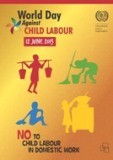 When I was younger, I use to joke with my parents that they were forcing me to do child labor for them by carrying two heavy loads of laundry or soda packages.
When I was younger, I use to joke with my parents that they were forcing me to do child labor for them by carrying two heavy loads of laundry or soda packages.
But child labor is really not something that should not be taken lightly when so many children in the world are deprived of an education and childhood.
On June 12 is World Day Against Child Labour, a day created by the International Labour Organization (ILO) in 2002. This day is meant to grow worldwide attention to this issue while also reminding us that children around the world are still mistreated. According to the ILO, child labor refers to work that is mentally, physically, socially or morally dangerous and harmful to children. This work can interfere with their schooling by depriving them of the opportunity to attend school, obligating them to leave school prematurely or requiring them to attempt to combine school attendance with excessively long and heavy work. Conditions in which these children preform vary since they may have various objectives. Child labor can come in more than one form such as domestic slavery or sexual slavery just to give an example.
The theme for World Day Against Child Labour 2013 is “No to child labour in domestic work.“
An estimated 10.5 million children worldwide – most of them under age – are working as domestic workers in people’s homes, in hazardous and sometimes slavery-like conditions, says the ILO.
Six and a half million of these child labourers are aged between five and 14 years-old. More than 71 per cent are girls.
According to the latest figures in a new ILO report, Ending Child labour in domestic work, they work in the homes of a third party or employer, carrying out tasks such as cleaning, ironing, cooking, gardening, collecting water, looking after other children and caring for the elderly.
Vulnerable to physical, psychological and sexual violence and abusive working conditions, they are often isolated from their families, hidden from the public eye and become highly dependent on their employers. Many might end up being commercially sexually exploited.
Even though there are bans on child labor in certain countries such as India, the bans are not effective because of lack of implementation. An article in the New York Times stated that in India, two young teenage boy miners are the perfect picture as to some conditions that child laborers endure. Both teenage boys wore t-shirts, pajama like pants with no protective gear given while they crawl through mounds of mud and mine for coal in a black pit while the other was studying from his text in an poor lit area. Stories of the abuse of children are all too common.
What can we do?
- Support programs that educate children and encourage parents to keep their children in school. Children in school are less likely to be trafficked.
- Inform ourselves.
The ILO suggests that we find out if our Government has ratified the ILO Conventions on child labour. See the list of countries who have ratified ILO Convention No. 138 and ILO Convention No. 182. If our government has not ratified the Conventions, write a letter to your government leaders to urge them to do so. If our government has ratified the Conventions, find out what is being done to implement them. - Find more ideas from the UN.